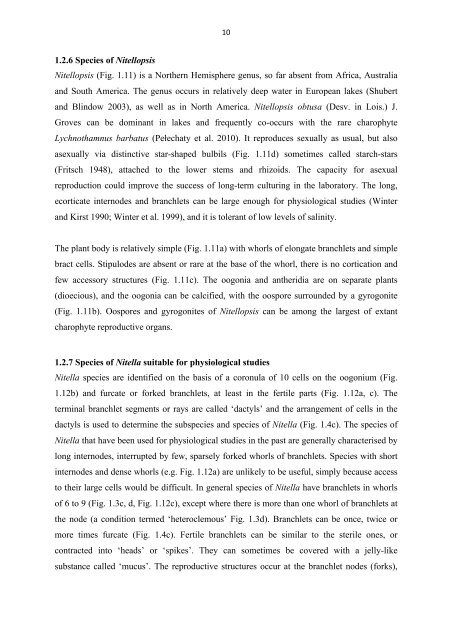Chapter 1: The Characeae Plant
Chapter 1: The Characeae Plant
Chapter 1: The Characeae Plant
Create successful ePaper yourself
Turn your PDF publications into a flip-book with our unique Google optimized e-Paper software.
10 <br />
1.2.6 Species of Nitellopsis<br />
Nitellopsis (Fig. 1.11) is a Northern Hemisphere genus, so far absent from Africa, Australia<br />
and South America. <strong>The</strong> genus occurs in relatively deep water in European lakes (Shubert<br />
and Blindow 2003), as well as in North America. Nitellopsis obtusa (Desv. in Lois.) J.<br />
Groves can be dominant in lakes and frequently co-occurs with the rare charophyte<br />
Lychnothamnus barbatus (Pełechaty et al. 2010). It reproduces sexually as usual, but also<br />
asexually via distinctive star-shaped bulbils (Fig. 1.11d) sometimes called starch-stars<br />
(Fritsch 1948), attached to the lower stems and rhizoids. <strong>The</strong> capacity for asexual<br />
reproduction could improve the success of long-term culturing in the laboratory. <strong>The</strong> long,<br />
ecorticate internodes and branchlets can be large enough for physiological studies (Winter<br />
and Kirst 1990; Winter et al. 1999), and it is tolerant of low levels of salinity.<br />
<strong>The</strong> plant body is relatively simple (Fig. 1.11a) with whorls of elongate branchlets and simple<br />
bract cells. Stipulodes are absent or rare at the base of the whorl, there is no cortication and<br />
few accessory structures (Fig. 1.11c). <strong>The</strong> oogonia and antheridia are on separate plants<br />
(dioecious), and the oogonia can be calcified, with the oospore surrounded by a gyrogonite<br />
(Fig. 1.11b). Oospores and gyrogonites of Nitellopsis can be among the largest of extant<br />
charophyte reproductive organs.<br />
1.2.7 Species of Nitella suitable for physiological studies<br />
Nitella species are identified on the basis of a coronula of 10 cells on the oogonium (Fig.<br />
1.12b) and furcate or forked branchlets, at least in the fertile parts (Fig. 1.12a, c). <strong>The</strong><br />
terminal branchlet segments or rays are called ‘dactyls’ and the arrangement of cells in the<br />
dactyls is used to determine the subspecies and species of Nitella (Fig. 1.4c). <strong>The</strong> species of<br />
Nitella that have been used for physiological studies in the past are generally characterised by<br />
long internodes, interrupted by few, sparsely forked whorls of branchlets. Species with short<br />
internodes and dense whorls (e.g. Fig. 1.12a) are unlikely to be useful, simply because access<br />
to their large cells would be difficult. In general species of Nitella have branchlets in whorls<br />
of 6 to 9 (Fig. 1.3c, d, Fig. 1.12c), except where there is more than one whorl of branchlets at<br />
the node (a condition termed ‘heteroclemous’ Fig. 1.3d). Branchlets can be once, twice or<br />
more times furcate (Fig. 1.4c). Fertile branchlets can be similar to the sterile ones, or<br />
contracted into ‘heads’ or ‘spikes’. <strong>The</strong>y can sometimes be covered with a jelly-like<br />
substance called ‘mucus’. <strong>The</strong> reproductive structures occur at the branchlet nodes (forks),
















